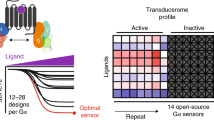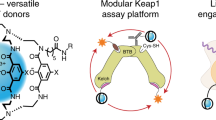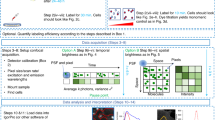Abstract
Cell surface receptors represent a vast majority of drug targets. Efforts have been conducted to develop biosensors reporting their conformational changes in live cells for pharmacological and functional studies. Although Förster resonance energy transfer (FRET) appears to be an ideal approach, its use is limited by the low signal-to-noise ratio. Here we report a toolbox composed of a combination of labeling technologies, specific fluorophores compatible with time-resolved FRET and a novel method to quantify signals. This approach enables the development of receptor biosensors with a large signal-to-noise ratio. We illustrate the usefulness of this toolbox through the development of biosensors for various G-protein-coupled receptors and receptor tyrosine kinases. These receptors include mGlu, GABAB, LH, PTH, EGF and insulin receptors among others. These biosensors can be used for high-throughput studies and also revealed new information on the activation process of these receptors in their cellular environment.
This is a preview of subscription content, access via your institution
Access options
Access Nature and 54 other Nature Portfolio journals
Get Nature+, our best-value online-access subscription
$29.99 / 30 days
cancel any time
Subscribe to this journal
Receive 12 print issues and online access
$259.00 per year
only $21.58 per issue
Buy this article
- Purchase on Springer Link
- Instant access to full article PDF
Prices may be subject to local taxes which are calculated during checkout






Similar content being viewed by others
References
Rask-Andersen, M., Masuram, S. & Schiöth, H.B. The druggable genome: evaluation of drug targets in clinical trials suggests major shifts in molecular class and indication. Annu. Rev. Pharmacol. Toxicol. 54, 9–26 (2014).
Thomsen, W., Frazer, J. & Unett, D. Functional assays for screening GPCR targets. Curr. Opin. Biotechnol. 16, 655–665 (2005).
Lemmon, M.A. & Schlessinger, J. Cell signaling by receptor tyrosine kinases. Cell 141, 1117–1134 (2010).
Boute, N., Jockers, R. & Issad, T. The use of resonance energy transfer in high-throughput screening: BRET versus FRET. Trends Pharmacol. Sci. 23, 351–354 (2002).
Lohse, M.J., Maiellaro, I. & Calebiro, D. Kinetics and mechanism of G-protein-coupled receptor activation. Curr. Opin. Cell Biol. 27, 87–93 (2014).
Ramanoudjame, G., Du, M., Mankiewicz, K.A. & Jayaraman, V. Allosteric mechanism in AMPA receptors: a FRET-based investigation of conformational changes. Proc. Natl. Acad. Sci. USA 103, 10473–10478 (2006).
Tateyama, M., Abe, H., Nakata, H., Saito, O. & Kubo, Y. Ligand-induced rearrangement of the dimeric metabotropic glutamate receptor 1alpha. Nat. Struct. Mol. Biol. 11, 637–642 (2004).
Nikolaev, V.O., Hoffmann, C., Bünemann, M., Lohse, M.J. & Vilardaga, J.P. Molecular basis of partial agonism at the neurotransmitter alpha-2A-adrenergic receptor and Gi-protein heterotrimer. J. Biol. Chem. 281, 24506–24511 (2006).
Vilardaga, J.P., Steinmeyer, R., Harms, G.S. & Lohse, M.J. Molecular basis of inverse agonism in a G protein-coupled receptor. Nat. Chem. Biol. 1, 25–28 (2005).
Tateyama, M. & Kubo, Y. Dual signaling is differentially activated by different active states of the metabotropic glutamate receptor 1alpha. Proc. Natl. Acad. Sci. USA 103, 1124–1128 (2006).
Vogel, S.S., Thaler, C. & Koushik, S.V. Fanciful FRET. Sci. STKE 2006, re2 (2006).
Angers, S. et al. Detection of beta 2-adrenergic receptor dimerization in living cells using bioluminescence resonance energy transfer (BRET). Proc. Natl. Acad. Sci. USA 97, 3684–3689 (2000).
De, A., Ray, P., Loening, A.M. & Gambhir, S.S. BRET3: a red-shifted bioluminescence resonance energy transfer (BRET)-based integrated platform for imaging protein-protein interactions from single live cells and living animals. FASEB J. 23, 2702–2709 (2009).
Xu, Y., Piston, D.W. & Johnson, C.H. A bioluminescence resonance energy transfer (BRET) system: application to interacting circadian clock proteins. Proc. Natl. Acad. Sci. USA 96, 151–156 (1999).
Bazin, H., Trinquet, E. & Mathis, G. Time resolved amplification of cryptate emission: a versatile technology to trace biomolecular interactions. J. Biotechnol. 82, 233–250 (2002).
Selvin, P.R. Principles and biophysical applications of lanthanide-based probes. Annu. Rev. Biophys. Biomol. Struct. 31, 275–302 (2002).
Lakowicz, J.R. Principles of Fluorescence Spectroscopy. 3rd ed. (Springer, 2006).
Encell, L.P. et al. Development of a dehalogenase-based protein fusion tag capable of rapid, selective and covalent attachment to customizable ligands. Curr. Chem. Genomics 6, 55–71 (2012).
Gautier, A. et al. An engineered protein tag for multiprotein labeling in living cells. Chem. Biol. 15, 128–136 (2008).
George, N., Pick, H., Vogel, H., Johnsson, N. & Johnsson, K. Specific labeling of cell surface proteins with chemically diverse compounds. J. Am. Chem. Soc. 126, 8896–8897 (2004).
Keppler, A. et al. A general method for the covalent labeling of fusion proteins with small molecules in vivo. Nat. Biotechnol. 21, 86–89 (2003).
Yin, J. et al. Genetically encoded short peptide tag for versatile protein labeling by Sfp phosphopantetheinyl transferase. Proc. Natl. Acad. Sci. USA 102, 15815–15820 (2005).
Fernández-Suárez, M. et al. Redirecting lipoic acid ligase for cell surface protein labeling with small-molecule probes. Nat. Biotechnol. 25, 1483–1487 (2007).
Brun, M.A. et al. Semisynthesis of fluorescent metabolite sensors on cell surfaces. J. Am. Chem. Soc. 133, 16235–16242 (2011).
Doumazane, E. et al. A new approach to analyze cell surface protein complexes reveals specific heterodimeric metabotropic glutamate receptors. FASEB J. 25, 66–77 (2011).
Hinner, M.J. & Johnsson, K. How to obtain labeled proteins and what to do with them. Curr. Opin. Biotechnol. 21, 766–776 (2010).
Masharina, A., Reymond, L., Maurel, D., Umezawa, K. & Johnsson, K. A fluorescent sensor for GABA and synthetic GABA(B) receptor ligands. J. Am. Chem. Soc. 134, 19026–19034 (2012).
Maurel, D. et al. Cell-surface protein–protein interaction analysis with time-resolved FRET and snap-tag technologies: application to GPCR oligomerization. Nat. Methods 5, 561–567 (2008).
Monnier, C. et al. Trans-activation between 7TM domains: implication in heterodimeric GABAB receptor activation. EMBO J. 30, 32–42 (2011).
Doumazane, E. et al. Illuminating the activation mechanisms and allosteric properties of metabotropic glutamate receptors. Proc. Natl. Acad. Sci. USA 110, E1416–E1425 (2013).
Olofsson, L. et al. Fine tuning of sub-millisecond conformational dynamics controls metabotropic glutamate receptors agonist efficacy. Nat. Commun. 5, 5206 (2014).
Geng, Y., Bush, M., Mosyak, L., Wang, F. & Fan, Q.R. Structural mechanism of ligand activation in human GABA(B) receptor. Nature 504, 254–259 (2013).
Yin, S. et al. Selective actions of novel allosteric modulators reveal functional heteromers of metabotropic glutamate receptors in the CNS. J. Neurosci. 34, 79–94 (2014).
Brock, C. et al. Activation of a dimeric metabotropic glutamate receptor by intersubunit rearrangement. J. Biol. Chem. 282, 33000–33008 (2007).
Lagerström, M.C. & Schiöth, H.B. Structural diversity of G-protein-coupled receptors and significance for drug discovery. Nat. Rev. Drug Discov. 7, 339–357 (2008).
Rasmussen, S.G. et al. Crystal structure of the β2 adrenergic receptor-Gs protein complex. Nature 477, 549–555 (2011).
Guo, W., Shi, L., Filizola, M., Weinstein, H. & Javitch, J.A. Crosstalk in G protein-coupled receptors: changes at the transmembrane homodimer interface determine activation. Proc. Natl. Acad. Sci. USA 102, 17495–17500 (2005).
Xue, L. et al. Major ligand-induced rearrangement of the heptahelical domain interface in a GPCR dimer. Nat. Chem. Biol. 11, 134–140 (2015).
Fan, Q.R. & Hendrickson, W.A. Structure of human follicle-stimulating hormone in complex with its receptor. Nature 433, 269–277 (2005).
Jiang, X. et al. Structure of follicle-stimulating hormone in complex with the entire ectodomain of its receptor. Proc. Natl. Acad. Sci. USA 109, 12491–12496 (2012).
Li, S. et al. Structural basis for inhibition of the epidermal growth factor receptor by cetuximab. Cancer Cell 7, 301–311 (2005).
Mattoon, D., Klein, P., Lemmon, M.A., Lax, I. & Schlessinger, J. The tethered configuration of the EGF receptor extracellular domain exerts only a limited control of receptor function. Proc. Natl. Acad. Sci. USA 101, 923–928 (2004).
Ozcan, F., Klein, P., Lemmon, M.A., Lax, I. & Schlessinger, J. On the nature of low- and high-affinity EGF receptors on living cells. Proc. Natl. Acad. Sci. USA 103, 5735–5740 (2006).
Croll, T.I. et al. Higher-resolution structure of the human insulin receptor ectodomain: multi-modal inclusion of the insert domain. Structure 24, 469–476 (2016).
Longo, F.M. & Massa, S.M. Small-molecule modulation of neurotrophin receptors: a strategy for the treatment of neurological disease. Nat. Rev. Drug Discov. 12, 507–525 (2013).
Couturier, C. & Jockers, R. Activation of the leptin receptor by a ligand-induced conformational change of constitutive receptor dimers. J. Biol. Chem. 278, 26604–26611 (2003).
Landes, C.F., Rambhadran, A., Taylor, J.N., Salatan, F. & Jayaraman, V. Structural landscape of isolated agonist-binding domains from single AMPA receptors. Nat. Chem. Biol. 7, 168–173 (2011).
El Moustaine, D. et al. Distinct roles of metabotropic glutamate receptor dimerization in agonist activation and G-protein coupling. Proc. Natl. Acad. Sci. USA 109, 16342–16347 (2012).
Bono, F. et al. Inhibition of tumor angiogenesis and growth by a small-molecule multi-FGF receptor blocker with allosteric properties. Cancer Cell 23, 477–488 (2013).
De Smet, F., Christopoulos, A. & Carmeliet, P. Allosteric targeting of receptor tyrosine kinases. Nat. Biotechnol. 32, 1113–1120 (2014).
Chung, I. et al. Spatial control of EGF receptor activation by reversible dimerization on living cells. Nature 464, 783–787 (2010).
Ward, C.W., Lawrence, M.C., Streltsov, V.A., Adams, T.E. & McKern, N.M. The insulin and EGF receptor structures: new insights into ligand-induced receptor activation. Trends Biochem. Sci. 32, 129–137 (2007).
Zwier, J.M., Bazin, H., Lamarque, L. & Mathis, G. Luminescent lanthanide cryptates: from the bench to the bedside. Inorg. Chem. 53, 1854–1866 (2014).
Rives, M.L. et al. Crosstalk between GABAB and mGlu1a receptors reveals new insight into GPCR signal integration. EMBO J. 28, 2195–2208 (2009).
Chen, T.W. et al. Ultrasensitive fluorescent proteins for imaging neuronal activity. Nature 499, 295–300 (2013).
Acknowledgements
The authors thank A. Jean and M. Allali from Cisbio Bioassays for help in the uHTS assays and the synthesis of compound 6, respectively, and G. Stewart, X. Rovira Algans and T. Durroux for helpful discussions. We thank H. Liu for the CaSR experiments. The authors also thank D. Maurel, L. Prézeau and the ARPEGE Pharmacology Screening-Interactome platform facility at the Institute for Functional Genomics (Montpellier, France). This work was supported by grants from Centre National de la Recherche Scientifique, the Institut National de la Santé et de la Recherche Médicale, Cisbio Bioassays, the Agence Nationale pour la Recherche (ANR-09-BIOT-018) (JPP and PR) the Fondation pour la Recherche Médicale (Equipe FRM DEQ20130326522) (JPP) and the Fondation Bettencourt Schueller (JPP). P.S. was supported by a CIFRE fellowship. E.D. was supported by a fellowship from the Fondation pour la Recherche Médicale and from the Association Schizo Oui.
Author information
Authors and Affiliations
Contributions
P.S., D.M.-D., N.L.-G., E.D., C.M., F.C.-S., L.F., C.C., G.D., T.R., J.M.Z., E.T., P.R. and J.-P.P. designed experiments; P.S., D.M.-D., E.D. and L.F. performed the mGluR and class A and B GPCR experiments; P.S., N.L.-G. and C.M. performed the GABAB experiments; P.S. and C.C. performed the RTK experiments; L.F. and G.D. performed the HTS experiments; S.S. and L.L. synthesized the compounds needed for this study; P.S., J.M.Z., P.R. and J.-P.P. wrote the manuscript.
Corresponding authors
Ethics declarations
Competing interests
Cisbio Bioassays is the manufacturer and the provider of most of the SNAP-tag and HaloTag reagents used in this study, and ACP-tag reagents may be commercialized in the future. A patent has been filled for the VFT sensor technology WO2010125314(A1).
Supplementary information
Supplementary Text and Figures
Supplementary Results, Supplementary Tables 1–2 and Supplementary Figures 1–6. (PDF 1010 kb)
Supplementary Note
Synthetic Procedures. (PDF 498 kb)
Rights and permissions
About this article
Cite this article
Scholler, P., Moreno-Delgado, D., Lecat-Guillet, N. et al. HTS-compatible FRET-based conformational sensors clarify membrane receptor activation. Nat Chem Biol 13, 372–380 (2017). https://doi.org/10.1038/nchembio.2286
Received:
Accepted:
Published:
Issue Date:
DOI: https://doi.org/10.1038/nchembio.2286
This article is cited by
-
Repurposing conformational changes in ANL superfamily enzymes to rapidly generate biosensors for organic and amino acids
Nature Communications (2023)
-
Structural basis of the activation of metabotropic glutamate receptor 3
Cell Research (2022)
-
Nanobody-based sensors reveal a high proportion of mGlu heterodimers in the brain
Nature Chemical Biology (2022)
-
Allosteric modulators enhance agonist efficacy by increasing the residence time of a GPCR in the active state
Nature Communications (2021)
-
Rearrangement of the transmembrane domain interfaces associated with the activation of a GPCR hetero-oligomer
Nature Communications (2019)



